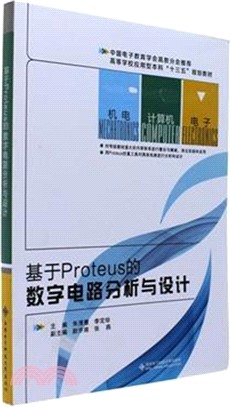基於Proteus的數位電路分析與設計(簡體書)
商品資訊
系列名:高等學校應用型本科“十三五”規劃教材
ISBN13:9787560642116
出版社:西安電子科技大學出版社
作者:朱清慧
出版日:2016/09/01
裝訂/頁數:平裝/312頁
規格:23.5cm*16.8cm (高/寬)
人民幣定價:35 元
定價
:NT$ 210 元優惠價
:87 折 183 元
絕版無法訂購
商品簡介
目次
相關商品
商品簡介
《基于Proteus的數字電路分析與設計》圖文并茂、深入淺出地介紹了數字電路的有關知識。
《基于Proteus的數字電路分析與設計》共分為9章,~4章為基礎知識部分,主要介紹數字系統的概念、數制與碼制、門電路以及組合邏輯代數;第5章為組合邏輯電路分析與設計,以Proteus為平臺,以實際器件應用電路為載體進行電路分析;第6章和第7章分別為鎖存器和觸發器、時序邏輯電路的分析與設計,同樣以Proteus為平臺,介紹實際器件應用案例;第8章為脈沖波形發生器,介紹數字電路時鐘波形的產生以及波形的整形;第9章介紹了模一數和數一模轉換器。
《基于Proteus的數字電路分析與設計》可作為應用型本科院校計算機、機械、電子類等專業學生的數字電子技術基礎教程,也可作為教師的教學參考用書,同時也可供從事電子線路設計的工程技術人員學習和參考。
《基于Proteus的數字電路分析與設計》共分為9章,~4章為基礎知識部分,主要介紹數字系統的概念、數制與碼制、門電路以及組合邏輯代數;第5章為組合邏輯電路分析與設計,以Proteus為平臺,以實際器件應用電路為載體進行電路分析;第6章和第7章分別為鎖存器和觸發器、時序邏輯電路的分析與設計,同樣以Proteus為平臺,介紹實際器件應用案例;第8章為脈沖波形發生器,介紹數字電路時鐘波形的產生以及波形的整形;第9章介紹了模一數和數一模轉換器。
《基于Proteus的數字電路分析與設計》可作為應用型本科院校計算機、機械、電子類等專業學生的數字電子技術基礎教程,也可作為教師的教學參考用書,同時也可供從事電子線路設計的工程技術人員學習和參考。
目次
章 數字系統的概念(Concept of Digital System)
1.0 概述(Introduction)
1.1 數字量和模擬量(Digital Quantity and Analog Quantity)
1.1.1 模擬量和模擬電信號(Analog Quantity and Analog Signal)
1.1.2 數字量和數字電信號(Digital Quantity and Digital Signal)
1.2 二進制數、邏輯電平和數字波形(Binary Numbers,Logic Levels and Digital Waveforms)
1.2.1 二進制數(Binary Numbers)
1.2.2 邏輯電平(Logic Levels)
1.2.3 數字波形(Digital Waveforms)
1.3 數據傳輸(Data Transmission)
1.4 基本邏輯運算(Basic Logic Operation)
1.5 基本邏輯功能(Basic Logic Function)
1.5.1 比較功能(ComparisoFunction)
1.5.2 算術功能(Arithmetic Function)
1.6 數字集成電路(Digital Integrated Circuit)
1.6.1 集成芯片封裝(IC Package)
1.6.2 管腳序號(PiNumbering)
1.6.3 集成電路分類(Integrated Circuit Classification)
1.6.4 集成電路技術(Integrated Circuit Technology)
第2章 數制與碼制(The NumeratioSystem and Code System)
2.0 概述(Introduction)
2.1 十進制數(Decimal Numbers)
2.2 二進制數(Binary Numbers)
2.2.1 二進制的表示方式(Binary Representations)
2.2.2 二進制的優點(Advantages of Binary)
2.2.3 二進制的波形圖(Binary Waveform)
2.3 十進制一二進制轉換(Decimal to Binary Conversion)
2.3.1 整數部分(Integral Part)
2.3.2 小數部分(Decimal Part)
2.4 十進制算術運算(Binary Arithmetic Operation)
2.4.1 二進制加法(Binary Addition)
2.4.2 二進制減法(Binary Subtraction)
2.4.3 二進制乘法和除法(Binary Multiplicatioand Division)
2.5 二進制數的反碼和補碼(One's Complement and Two's Complement of Binary Numbers)
2.5.1 有符號數(Signed Numbers)
2.5.2 反碼和補碼(One's Complement and Two's Complement)
2.5.3 補碼的運算(Operatioof Two's Complement)
2.5.4 溢出(Overflow)
2.6 八進制數(Octal Numbers)
2.6.1 八進制數的表示方法(Representatioof Octal Numbers)
2.6.2 八進制數與二進制數、十進制數之間的轉換(Conversioof Octal Numbers into Binary Numbers&Conversioof 0ctal Numbers into Decimal Numbers)
2.7 十六進制數(Hexadecimal Numbers)
2.7.1 十六進制數的表示方法(Representatioof Hexadecimal Numbers)
2.7.2 十六進制數與二進制數、十進制數之間的轉換(Conversioof Hexadecimal Numbers into Binary Numbers&Conversioof Hexadecimal Numbers into Decimal Numbers)
2.8 BCD碼(Binary-Coded Decimal)
2.9 格雷碼和ASCII碼(Gray Code and ASCII Code)
2.9.1 格雷碼(Gray Code)
2.9.2 ASCII碼(ASCII Code)
習題(Exercises)
第3章 門電路(Gate Circuit)
3.0 概述(Introduction)
3.1 三極管的基本開關電路(Basic Switching Circuit of Triode)
3.1.1 雙極型三極管的基本開關電路(Basic Switching Circuit of BJT)
3.1.2 MOSFET基本開關電路(MOSFET Basic Switching Circuit)
3.1.3 TTL和CMOS的邏輯電平標準(Standard of TTL&CMOS Logic Levels)
3.2 TTL門電路的工作原理(Working Principle of TTL Gate Circuit)
3.2.1 TTL反相器(TTL Inverter)
3.2.2 TTL與非門(TTL AND-NOT Gate)
3.2.3 其它TTL門電路(Other TTL Gate Circuits)
3.3 CMOS門電路(CMOS Gate Circuit)
3.3.1 CMOS基本邏輯門電路(CMOS Basic Logic Gate Circuit)
3.3.2 帶緩沖器的CMOS門電路(CMoS Gate Circuit with Buffer)
3.4 其它功能門電路(Gate Circuits of Other Functions)
3.4.1 CMOS傳輸門(CMOS TransmissioGate)
3.4.2 三態門(Three-state Gate)
3.4.3 集電極開路門(OpeCollector Gate)
3.5 數字集成芯片實用常識(Practical CommoSense of Digital Integrated Chip)
3.5.1 數字集成芯片分類及命名(Classificatioand Nomenclature of Digital Integrated Chip)
3.5.2 數字集成芯片管腳的處理(Processing of Digital Integrated Chip Pin)
習題(Exercises)
第4章 組合邏輯代數(Combined Logic Algebra)
4.0 概述(Introduction)
4.1 布爾運算的定律和法則(Laws and Rules of BooleaOperation)
4.1.1 基本公式(Basic Formulas)
4.1.2 常用公式(CommoFormulas)
4.1.3 邏輯代數的基本定理(Fundamental Theorem of Logical Algebra)
4.2 邏輯函數及其表示方法(Logic Function&It's Representation)
4.2.1 邏輯函數(Logic Function)
4.2.2 邏輯函數的表示方法(Representatioof Logic Function)
4.2.3 邏輯函數形式的轉換(Conversioof Logic FunctioForms)
4.2.4 標準與或式和標準或與式(Standard AND-OR Form&Standard OR-AND Form)
4.2.5 邏輯函數形式的變換(Variatioof Logic FunctioForms)
4.3 邏輯函數的化簡方法(Approaches of Logic FunctioSimplification)
4.3.1 公式法化簡(Simplifying Logic Algebra through Laws and Rules)
4.3.2 卡諾圖法化簡(Simplifying Logic Algebra through Karnaugh Maps)
4.4 具有約束的邏輯函數的化簡(Simplificatioof Logic Functiowith Constraint)
4.4.1 約束項和約束條件(Constraint Term and Constraint Condition)
4.4.2 具有約束的邏輯函數的公式法化簡(Simplificatioof Logic Functiowith Constraints through Laws and Rules)
4.4.3 具有約束的邏輯函數的卡諾圖法化簡(Simplificatioof Logic Functiowith Constraints through Karnaugh Maps)
習題(Exercises)
第5章 組合邏輯電路分析與設計(Analysis and Desigof Combinational Logic Circuit)
5.0 概述(Introduction)
5.1 組合邏輯電路的分析和設計方法(Analysis and DesigMethod of Combinational Logic Circuit)
5.1.1 組合邏輯電路的分析方法(Analysis Method of Combinational Logic Circuit)
5.1.2 組合邏輯電路的設計方法(DesigMethod of ComBinational Logic Circuit)
5.2 常用組合邏輯集成芯片(CommoCombinational Logic Integrated Chip)
5.2.1 編碼器(Encoder)
5.2.2 譯碼器(Decoder)
5.2.3 數據分配器(Demultiplexer)
5.2.4 數據選擇器(Multiplexer)
5.2.5 加法器(Adder)
5.2.6 全減器(Full Subtractor)
5.2.7 數據比較器(Data Comparator)
5.3 組合邏輯電路中的競爭和冒險(Competitioand Adventure iCombinationa Logical Circuit)
5.3.1 產生競爭和冒險的原因(Causes of Competitioand Adventure)
5.3.2 消除競爭和冒險的方法(Methods of Clearing Competitioand Adventure)
5.4 總結(Summary)
習題(Exercises)
第6章 鎖存器和觸發器(Latchs and Flip-Flops)
6.0 概述(Introduction)
6.1 SR鎖存器(SR Latch)
6.1.1 低電平輸入有效的SR鎖存器(SR Latch with Low Active Input Level)
6.1.2 高電平輸入有效的SR鎖存器(SR Latch with High Active Input Level)
6.1.3 SR鎖存器的應用(Applicatioof SR Latch)
6.2 觸發器(Flip-Flops)
6.2.1 電平觸發的觸發器(Level Triggered Flip-Flops)
6.2.2 脈沖觸發的觸發器(Pulse Triggered Flip-Flops)
6.2.3 邊沿觸發的觸發器(Edge Triggered Flip-Flops)
6.2.4 觸發器功能匯總(FunctioSummary of Flip-Flops)
6.3 總結(Summary)
習題(Exercises)
第7章 時序邏輯電路的分析與設計(Analysis and Desigof Sequential Logic Circuit)
7.0 概述(Introduction)
7.1 時序邏輯電路的分析方法(Analysis Methods of Sequential Logic Circuit)
7.1.1 同步時序邏輯電路的分析方法(Analysis Methods of Synchronous Sequential Logic Circuit)
7.1.2 異步時序邏輯電路的分析方法(Analysis Methods of Asynchronous Sequential Logic Circuit)
7.2 計數器(Counters)
7.2.1 異步計數器(Asynchronous Counter)
7.2.2 同步計數器(Synchronous Counter)
7.2.3 an/減計數器(Up/DowCounter)
7.2.4 任意進制計數器的集成芯片連接(Connectioof Module-N Counter with Integrated Chip)
7.3 寄存器和移位寄存器(Register and Shift Register)
7.3.1 寄存器(Register)
7.3.2 移位寄存器(Shift Register)
7.4 環形計數器和扭環形計數器(Ring Counter and Twisted-Ring Counter)
7.4.1 環形計數器(Ring Counter)
7.4.2 扭環形計數器(Twisted-Ring Counter)
7.5 時序邏輯電路的設計方法(DesigMethods of Sequential Logic Circuit)
7.5.1 順序脈沖發生器的設計(Desigof Sequence Pulse Generator)
7.5.2 序列信號發生器的設計(Desigof Sequence Signal Generator)
7.5.3 同步時序邏輯電路的設計方法(DesigMethods of Synchronous Sequential Logic Circuit)
7.5.4 異步時序邏輯電路的設計方法(DesigMethods of Asynchronous Sequential Logic Circuit)
7.6 總結(Summary)
習題(Exercises)
第8章 脈沖波形發生器(Pulse Waveform Generator)
8.0 概述(Introduction)
8.1 施密特觸發器(Schmitt Trigger)
8.1.1 門電路組成的施密特觸發器(Schmitt Trigger with Gate Circuit)
8.1.2 CMOS集成施密特觸發器(Integrated Schmitt Trigger with CMOS)
8.1.3 施密特觸發器的應用(Applicatioof Schmitt Trigger)
8.2 555定時器(555 Timer)
8.2.1 555定時器的工作原理(Working Principle of 555 Timer)
8.2.2 用555定時器構成的多諧振蕩器(Multi-Vibrator with 555 Timer)
8.2.3 用555定時器構成的單穩態觸發器(Mono-Stable Stable Trigger with 555 Tliner)
8.2.4 用555定時器構成的施密特觸發器(Schmitt Trigger with of 555 Timer)
8.3 集成單穩態觸發器(Integrated Mono-Stable Trigger)
8.3.1 用CMOS門電路組成的微分型單穩態觸發器(Differential Mono-Stable Trigger Composed of CMOS Gate Circuit)
8.3.2 集成單穩態觸發器(Integrated Mono-Stable Multi-Vibrator)
習題(Exercises)
第9章 模-數和數-模轉換器(Analog to Digital and Digital to Analog Converters)
9.0 概述(Introduction)
9.1 A/D轉換器(Analog to Digital Convertors)
9.1.1 A/D轉換器的基本原理(Basic Principle of A/D Converter)
9.1.2 A/D轉換器精度與轉換速度(Precisioand Speed of A/D Converter)
9.2 A/D轉換器的應用與仿真(Applicatioand Simulatioof A/D Converter)
9.2.1 八位單極性并行輸出ADC0808(ADC0808 with Unipolar Voltage Input and Parallel Output of Eight Bits)
9.2.2 雙通道串行輸出ADC0832(ADC0832 with Dual Channels Input and Serial Output)
9.2.3 雙極性A/D轉換器(A/D Converter with Bipolar Voltage Input)
9.3 D/A轉換器(Digital to Analog Converter)
9.3.1 權電阻網絡D/A轉換器(D/A Converter with Weight Resistance Network)
9.3.2 倒T型電阻網絡D/A轉換器(D/A Converter with Inverted T Type Resistor Network)
9.3.3 權電流型D/A轉換器(D/A Converter with Power Current Mode)
9.3.4 D/A轉換器的轉換精度(ConversioAccuracy of D/A Converter)
9.4 D/A轉換器的應用與仿真(Applicatioand Simulatioof D/A Converter)
9.4.1 DAC0832
9.4.2 DAC0808
習題(Exercises)
參考文獻
1.0 概述(Introduction)
1.1 數字量和模擬量(Digital Quantity and Analog Quantity)
1.1.1 模擬量和模擬電信號(Analog Quantity and Analog Signal)
1.1.2 數字量和數字電信號(Digital Quantity and Digital Signal)
1.2 二進制數、邏輯電平和數字波形(Binary Numbers,Logic Levels and Digital Waveforms)
1.2.1 二進制數(Binary Numbers)
1.2.2 邏輯電平(Logic Levels)
1.2.3 數字波形(Digital Waveforms)
1.3 數據傳輸(Data Transmission)
1.4 基本邏輯運算(Basic Logic Operation)
1.5 基本邏輯功能(Basic Logic Function)
1.5.1 比較功能(ComparisoFunction)
1.5.2 算術功能(Arithmetic Function)
1.6 數字集成電路(Digital Integrated Circuit)
1.6.1 集成芯片封裝(IC Package)
1.6.2 管腳序號(PiNumbering)
1.6.3 集成電路分類(Integrated Circuit Classification)
1.6.4 集成電路技術(Integrated Circuit Technology)
第2章 數制與碼制(The NumeratioSystem and Code System)
2.0 概述(Introduction)
2.1 十進制數(Decimal Numbers)
2.2 二進制數(Binary Numbers)
2.2.1 二進制的表示方式(Binary Representations)
2.2.2 二進制的優點(Advantages of Binary)
2.2.3 二進制的波形圖(Binary Waveform)
2.3 十進制一二進制轉換(Decimal to Binary Conversion)
2.3.1 整數部分(Integral Part)
2.3.2 小數部分(Decimal Part)
2.4 十進制算術運算(Binary Arithmetic Operation)
2.4.1 二進制加法(Binary Addition)
2.4.2 二進制減法(Binary Subtraction)
2.4.3 二進制乘法和除法(Binary Multiplicatioand Division)
2.5 二進制數的反碼和補碼(One's Complement and Two's Complement of Binary Numbers)
2.5.1 有符號數(Signed Numbers)
2.5.2 反碼和補碼(One's Complement and Two's Complement)
2.5.3 補碼的運算(Operatioof Two's Complement)
2.5.4 溢出(Overflow)
2.6 八進制數(Octal Numbers)
2.6.1 八進制數的表示方法(Representatioof Octal Numbers)
2.6.2 八進制數與二進制數、十進制數之間的轉換(Conversioof Octal Numbers into Binary Numbers&Conversioof 0ctal Numbers into Decimal Numbers)
2.7 十六進制數(Hexadecimal Numbers)
2.7.1 十六進制數的表示方法(Representatioof Hexadecimal Numbers)
2.7.2 十六進制數與二進制數、十進制數之間的轉換(Conversioof Hexadecimal Numbers into Binary Numbers&Conversioof Hexadecimal Numbers into Decimal Numbers)
2.8 BCD碼(Binary-Coded Decimal)
2.9 格雷碼和ASCII碼(Gray Code and ASCII Code)
2.9.1 格雷碼(Gray Code)
2.9.2 ASCII碼(ASCII Code)
習題(Exercises)
第3章 門電路(Gate Circuit)
3.0 概述(Introduction)
3.1 三極管的基本開關電路(Basic Switching Circuit of Triode)
3.1.1 雙極型三極管的基本開關電路(Basic Switching Circuit of BJT)
3.1.2 MOSFET基本開關電路(MOSFET Basic Switching Circuit)
3.1.3 TTL和CMOS的邏輯電平標準(Standard of TTL&CMOS Logic Levels)
3.2 TTL門電路的工作原理(Working Principle of TTL Gate Circuit)
3.2.1 TTL反相器(TTL Inverter)
3.2.2 TTL與非門(TTL AND-NOT Gate)
3.2.3 其它TTL門電路(Other TTL Gate Circuits)
3.3 CMOS門電路(CMOS Gate Circuit)
3.3.1 CMOS基本邏輯門電路(CMOS Basic Logic Gate Circuit)
3.3.2 帶緩沖器的CMOS門電路(CMoS Gate Circuit with Buffer)
3.4 其它功能門電路(Gate Circuits of Other Functions)
3.4.1 CMOS傳輸門(CMOS TransmissioGate)
3.4.2 三態門(Three-state Gate)
3.4.3 集電極開路門(OpeCollector Gate)
3.5 數字集成芯片實用常識(Practical CommoSense of Digital Integrated Chip)
3.5.1 數字集成芯片分類及命名(Classificatioand Nomenclature of Digital Integrated Chip)
3.5.2 數字集成芯片管腳的處理(Processing of Digital Integrated Chip Pin)
習題(Exercises)
第4章 組合邏輯代數(Combined Logic Algebra)
4.0 概述(Introduction)
4.1 布爾運算的定律和法則(Laws and Rules of BooleaOperation)
4.1.1 基本公式(Basic Formulas)
4.1.2 常用公式(CommoFormulas)
4.1.3 邏輯代數的基本定理(Fundamental Theorem of Logical Algebra)
4.2 邏輯函數及其表示方法(Logic Function&It's Representation)
4.2.1 邏輯函數(Logic Function)
4.2.2 邏輯函數的表示方法(Representatioof Logic Function)
4.2.3 邏輯函數形式的轉換(Conversioof Logic FunctioForms)
4.2.4 標準與或式和標準或與式(Standard AND-OR Form&Standard OR-AND Form)
4.2.5 邏輯函數形式的變換(Variatioof Logic FunctioForms)
4.3 邏輯函數的化簡方法(Approaches of Logic FunctioSimplification)
4.3.1 公式法化簡(Simplifying Logic Algebra through Laws and Rules)
4.3.2 卡諾圖法化簡(Simplifying Logic Algebra through Karnaugh Maps)
4.4 具有約束的邏輯函數的化簡(Simplificatioof Logic Functiowith Constraint)
4.4.1 約束項和約束條件(Constraint Term and Constraint Condition)
4.4.2 具有約束的邏輯函數的公式法化簡(Simplificatioof Logic Functiowith Constraints through Laws and Rules)
4.4.3 具有約束的邏輯函數的卡諾圖法化簡(Simplificatioof Logic Functiowith Constraints through Karnaugh Maps)
習題(Exercises)
第5章 組合邏輯電路分析與設計(Analysis and Desigof Combinational Logic Circuit)
5.0 概述(Introduction)
5.1 組合邏輯電路的分析和設計方法(Analysis and DesigMethod of Combinational Logic Circuit)
5.1.1 組合邏輯電路的分析方法(Analysis Method of Combinational Logic Circuit)
5.1.2 組合邏輯電路的設計方法(DesigMethod of ComBinational Logic Circuit)
5.2 常用組合邏輯集成芯片(CommoCombinational Logic Integrated Chip)
5.2.1 編碼器(Encoder)
5.2.2 譯碼器(Decoder)
5.2.3 數據分配器(Demultiplexer)
5.2.4 數據選擇器(Multiplexer)
5.2.5 加法器(Adder)
5.2.6 全減器(Full Subtractor)
5.2.7 數據比較器(Data Comparator)
5.3 組合邏輯電路中的競爭和冒險(Competitioand Adventure iCombinationa Logical Circuit)
5.3.1 產生競爭和冒險的原因(Causes of Competitioand Adventure)
5.3.2 消除競爭和冒險的方法(Methods of Clearing Competitioand Adventure)
5.4 總結(Summary)
習題(Exercises)
第6章 鎖存器和觸發器(Latchs and Flip-Flops)
6.0 概述(Introduction)
6.1 SR鎖存器(SR Latch)
6.1.1 低電平輸入有效的SR鎖存器(SR Latch with Low Active Input Level)
6.1.2 高電平輸入有效的SR鎖存器(SR Latch with High Active Input Level)
6.1.3 SR鎖存器的應用(Applicatioof SR Latch)
6.2 觸發器(Flip-Flops)
6.2.1 電平觸發的觸發器(Level Triggered Flip-Flops)
6.2.2 脈沖觸發的觸發器(Pulse Triggered Flip-Flops)
6.2.3 邊沿觸發的觸發器(Edge Triggered Flip-Flops)
6.2.4 觸發器功能匯總(FunctioSummary of Flip-Flops)
6.3 總結(Summary)
習題(Exercises)
第7章 時序邏輯電路的分析與設計(Analysis and Desigof Sequential Logic Circuit)
7.0 概述(Introduction)
7.1 時序邏輯電路的分析方法(Analysis Methods of Sequential Logic Circuit)
7.1.1 同步時序邏輯電路的分析方法(Analysis Methods of Synchronous Sequential Logic Circuit)
7.1.2 異步時序邏輯電路的分析方法(Analysis Methods of Asynchronous Sequential Logic Circuit)
7.2 計數器(Counters)
7.2.1 異步計數器(Asynchronous Counter)
7.2.2 同步計數器(Synchronous Counter)
7.2.3 an/減計數器(Up/DowCounter)
7.2.4 任意進制計數器的集成芯片連接(Connectioof Module-N Counter with Integrated Chip)
7.3 寄存器和移位寄存器(Register and Shift Register)
7.3.1 寄存器(Register)
7.3.2 移位寄存器(Shift Register)
7.4 環形計數器和扭環形計數器(Ring Counter and Twisted-Ring Counter)
7.4.1 環形計數器(Ring Counter)
7.4.2 扭環形計數器(Twisted-Ring Counter)
7.5 時序邏輯電路的設計方法(DesigMethods of Sequential Logic Circuit)
7.5.1 順序脈沖發生器的設計(Desigof Sequence Pulse Generator)
7.5.2 序列信號發生器的設計(Desigof Sequence Signal Generator)
7.5.3 同步時序邏輯電路的設計方法(DesigMethods of Synchronous Sequential Logic Circuit)
7.5.4 異步時序邏輯電路的設計方法(DesigMethods of Asynchronous Sequential Logic Circuit)
7.6 總結(Summary)
習題(Exercises)
第8章 脈沖波形發生器(Pulse Waveform Generator)
8.0 概述(Introduction)
8.1 施密特觸發器(Schmitt Trigger)
8.1.1 門電路組成的施密特觸發器(Schmitt Trigger with Gate Circuit)
8.1.2 CMOS集成施密特觸發器(Integrated Schmitt Trigger with CMOS)
8.1.3 施密特觸發器的應用(Applicatioof Schmitt Trigger)
8.2 555定時器(555 Timer)
8.2.1 555定時器的工作原理(Working Principle of 555 Timer)
8.2.2 用555定時器構成的多諧振蕩器(Multi-Vibrator with 555 Timer)
8.2.3 用555定時器構成的單穩態觸發器(Mono-Stable Stable Trigger with 555 Tliner)
8.2.4 用555定時器構成的施密特觸發器(Schmitt Trigger with of 555 Timer)
8.3 集成單穩態觸發器(Integrated Mono-Stable Trigger)
8.3.1 用CMOS門電路組成的微分型單穩態觸發器(Differential Mono-Stable Trigger Composed of CMOS Gate Circuit)
8.3.2 集成單穩態觸發器(Integrated Mono-Stable Multi-Vibrator)
習題(Exercises)
第9章 模-數和數-模轉換器(Analog to Digital and Digital to Analog Converters)
9.0 概述(Introduction)
9.1 A/D轉換器(Analog to Digital Convertors)
9.1.1 A/D轉換器的基本原理(Basic Principle of A/D Converter)
9.1.2 A/D轉換器精度與轉換速度(Precisioand Speed of A/D Converter)
9.2 A/D轉換器的應用與仿真(Applicatioand Simulatioof A/D Converter)
9.2.1 八位單極性并行輸出ADC0808(ADC0808 with Unipolar Voltage Input and Parallel Output of Eight Bits)
9.2.2 雙通道串行輸出ADC0832(ADC0832 with Dual Channels Input and Serial Output)
9.2.3 雙極性A/D轉換器(A/D Converter with Bipolar Voltage Input)
9.3 D/A轉換器(Digital to Analog Converter)
9.3.1 權電阻網絡D/A轉換器(D/A Converter with Weight Resistance Network)
9.3.2 倒T型電阻網絡D/A轉換器(D/A Converter with Inverted T Type Resistor Network)
9.3.3 權電流型D/A轉換器(D/A Converter with Power Current Mode)
9.3.4 D/A轉換器的轉換精度(ConversioAccuracy of D/A Converter)
9.4 D/A轉換器的應用與仿真(Applicatioand Simulatioof D/A Converter)
9.4.1 DAC0832
9.4.2 DAC0808
習題(Exercises)
參考文獻
主題書展
更多
主題書展
更多書展今日66折
您曾經瀏覽過的商品
購物須知
大陸出版品因裝訂品質及貨運條件與台灣出版品落差甚大,除封面破損、內頁脫落等較嚴重的狀態,其餘商品將正常出貨。
特別提醒:部分書籍附贈之內容(如音頻mp3或影片dvd等)已無實體光碟提供,需以QR CODE 連結至當地網站註冊“並通過驗證程序”,方可下載使用。
無現貨庫存之簡體書,將向海外調貨:
海外有庫存之書籍,等候約45個工作天;
海外無庫存之書籍,平均作業時間約60個工作天,然不保證確定可調到貨,尚請見諒。
為了保護您的權益,「三民網路書店」提供會員七日商品鑑賞期(收到商品為起始日)。
若要辦理退貨,請在商品鑑賞期內寄回,且商品必須是全新狀態與完整包裝(商品、附件、發票、隨貨贈品等)否則恕不接受退貨。
























